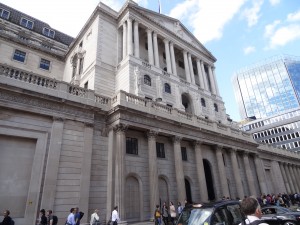 We have reported frequently in our blogs about concerns over rising debt levels among UK households. We previously noted the concerns expressed in July 2014 by the Prudential Regulation Authority (PRA) that the growth in consumer credit (unsecured lending) was stretching the financial well-being of individuals with implications for the resilience of lenders’ credit portfolios. Now the Chief Executive of the Financial Conduct Authority (FCA), Andrew Bailey, in an interview to the BBC has identified the growing problem of debt among young people.
We have reported frequently in our blogs about concerns over rising debt levels among UK households. We previously noted the concerns expressed in July 2014 by the Prudential Regulation Authority (PRA) that the growth in consumer credit (unsecured lending) was stretching the financial well-being of individuals with implications for the resilience of lenders’ credit portfolios. Now the Chief Executive of the Financial Conduct Authority (FCA), Andrew Bailey, in an interview to the BBC has identified the growing problem of debt among young people.
In his interview Mr Bailey stresses that the growth in debt amongst younger people is not ‘reckless borrowing’ and so not borne out of a lack of willpower or ‘present bias’ (see John’s blog Nudging mainstream economists). Rather, it is borrowing simply to meet basic living costs.
In his interview Mr Bailey goes on to identify generational shifts in patterns of wealth and debt. He notes:
There are particular concentrations [of debt] in society, and those concentrations are particularly exposed to some of the forms and practices of high cost debt which we are currently looking at very closely because there are things in there that we don’t like.
There has been a clear shift in the generational pattern of wealth and income, and that translates into a greater indebtedness at a younger age. That reflects lower levels of real income, lower levels of asset ownership. There are quite different generational experiences.
 Mr Bailey goes on to echo concerns expressed back in July by the Prudential Regulation Authority in relation to the growth in consumer credit. The chart illustrates the scale of the accumulation of consumer credit (unsecured lending) across all individuals in the UK. In August 2017 the stock of unsecured debt rose to £203 billion, the highest level since December 2008 when the financial crisis was unfolding. (Click here to download a PowerPoint of the chart).
Mr Bailey goes on to echo concerns expressed back in July by the Prudential Regulation Authority in relation to the growth in consumer credit. The chart illustrates the scale of the accumulation of consumer credit (unsecured lending) across all individuals in the UK. In August 2017 the stock of unsecured debt rose to £203 billion, the highest level since December 2008 when the financial crisis was unfolding. (Click here to download a PowerPoint of the chart).
In concluding his BBC interview, Mr Bailey notes that credit should be available to younger people. Credit helps individuals to ‘smooth income’ and that this is something which is increasingly important with more people having erratic incomes as the gig-economy continues to grow. However, he notes that credit provision needs to be “sustainable”.
BBC Interview
Financial regulator warns of growing debt among young people BBC News (16/10/17)
Articles
Young people are borrowing to cover basic living costs, warns City watchdog Guardian, Julia Kollewe (16/10/17)
Britain’s debt timebomb: FCA urges action over £200bn crisis Guardian, Phillip Inman and Jill Treanor (18/9/17)
FCA warning that young are borrowing to eat shames Britain Independent, James Moore (16/7/17)
Young people are ‘borrowing to cover basic living costs’ and increasing numbers are going bankrupt, warns financial watchdog Daily Mail, Kate Ferguson (6/10/17)
More and more young people are falling into debt – but it’s not their fault Metro, Alex Simpson (20/10/17)
Data
Bankstats (Monetary and Financial Statistics) – Latest Tables Bank of England
Statistical Interactive Database Bank of England
Questions
- What does it mean if people are financially distressed?
- What do you think Mr Bailey means by ‘sustainable credit’?
- In what ways might levels of debt impact on the macroeconomy?
- How does credit help to smooth spending patterns? Why might this be more important with the growth in the gig-economy?
- What is meant by inter-generational fairness?
- Of what relevance are changing patterns in wealth and debt to inter-generational fairness? What factors might be driving these patterns?
- What sort of credit is unsecured credit? How does it differ from secured credit?
- Are there measures that policymakers can take to reduce the likelihood that flows of credit become too excessive?
 An economy that becomes dependent on credit can, in turn, become acutely volatile. Too much credit and there exists the potential for financial distress which can result in an economic slowdown as people cut back on spending. Too little credit and the growth in aggregate demand is subdued. Some argue that this is what now faces a financialised economy like the UK. Even it this overstates the significance of credit, there is no doubt that UK credit data is keenly followed by economists and policymakers.
An economy that becomes dependent on credit can, in turn, become acutely volatile. Too much credit and there exists the potential for financial distress which can result in an economic slowdown as people cut back on spending. Too little credit and the growth in aggregate demand is subdued. Some argue that this is what now faces a financialised economy like the UK. Even it this overstates the significance of credit, there is no doubt that UK credit data is keenly followed by economists and policymakers.
Recent rates of credit accumulation by individuals have raised concern. In July 2014 the Prudential Regulation Authority (PRA) of the Bank of England issued a statement voicing its concern that the growth in consumer credit, also known as unsecured lending, was stretching the financial well-being of individuals and that the resilience of lenders’ consumer credit portfolios was therefore reducing.
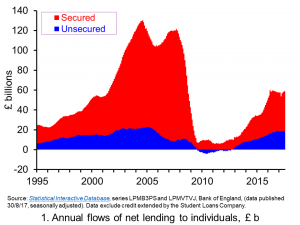 Chart 1 illustrates the scale of the flows of both consumer credit (unsecured lending) and mortgages (secured credit) from banks and building societies to individuals. It shows the amount of credit net of repayments lent over the last 12 months. In the 12 months to July 2017 the net accumulation of consumer credit was £18.2 billion while that of secured borrowing was £40.8 billion. Although the 12-month level of consumer credit accumulation was down from its recent peak of £19.2 billion in November 2016, total net lending (including secured lending) to individuals of £59.0 billion was its highest since September 2008. (Click here to download a PowerPoint of the chart).
Chart 1 illustrates the scale of the flows of both consumer credit (unsecured lending) and mortgages (secured credit) from banks and building societies to individuals. It shows the amount of credit net of repayments lent over the last 12 months. In the 12 months to July 2017 the net accumulation of consumer credit was £18.2 billion while that of secured borrowing was £40.8 billion. Although the 12-month level of consumer credit accumulation was down from its recent peak of £19.2 billion in November 2016, total net lending (including secured lending) to individuals of £59.0 billion was its highest since September 2008. (Click here to download a PowerPoint of the chart).
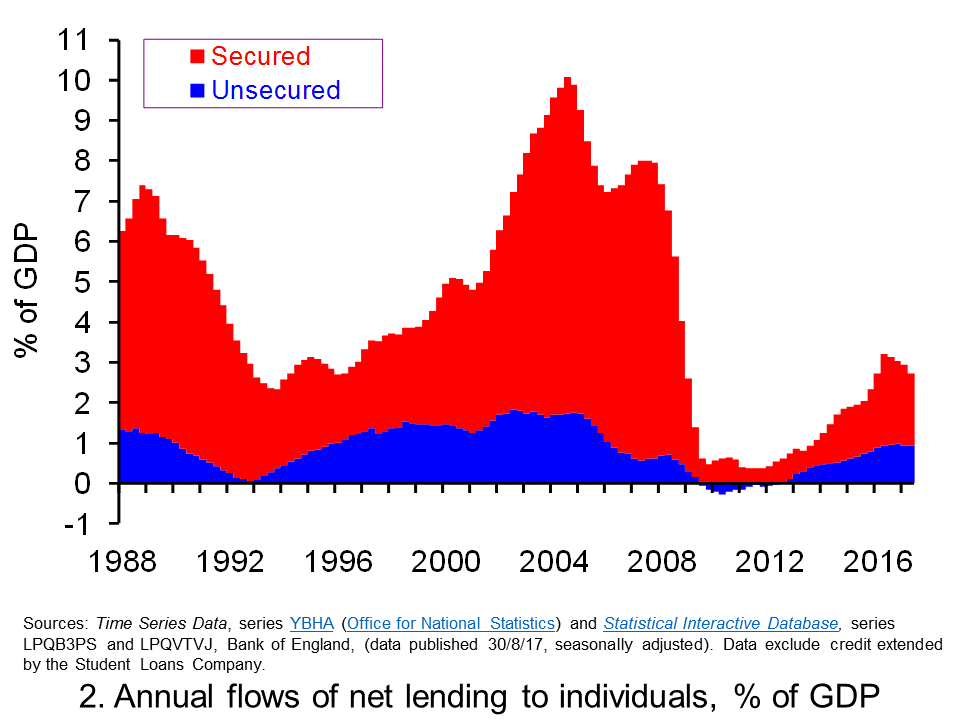 To help put in context the size of flows of net lending Chart 2 shows the annual flows of consumer credit and secured debt as percentages of GDP. In this case each observation measures net lending over the past four quarters as a percentage of annual GDP. The latest observation is for 2017 Q2 and shows that the annual net flow of consumer credit was equivalent to 0.94 per cent of GDP while that for secured borrowing was 1.78 per cent of GDP. While the flows of consumer credit and secured borrowing as shares of national income have eased a little from their values in the second half of last year, they have not eased significantly. (Click here to download a PowerPoint of the chart).
To help put in context the size of flows of net lending Chart 2 shows the annual flows of consumer credit and secured debt as percentages of GDP. In this case each observation measures net lending over the past four quarters as a percentage of annual GDP. The latest observation is for 2017 Q2 and shows that the annual net flow of consumer credit was equivalent to 0.94 per cent of GDP while that for secured borrowing was 1.78 per cent of GDP. While the flows of consumer credit and secured borrowing as shares of national income have eased a little from their values in the second half of last year, they have not eased significantly. (Click here to download a PowerPoint of the chart).
 Despite the recent strength of borrowing, levels are nothing like those seen in the mid 2000s. Nonetheless, we need to see the current accumulation of debt in the context of two important factors: debt already accumulated and the future macroeconomic environment. Chart 3 gives some insight to the first of these two by looking at stocks of debt outstanding as shares of GDP. The total debt-to-GDP ratio peaked 90 percent in 2009 before relatively slower growth in credit accumulation saw the ratio fall back. The ratio has now been at or around the 78 per cent level consistently for the past two or so years. (Click here to download a PowerPoint of the chart).
Despite the recent strength of borrowing, levels are nothing like those seen in the mid 2000s. Nonetheless, we need to see the current accumulation of debt in the context of two important factors: debt already accumulated and the future macroeconomic environment. Chart 3 gives some insight to the first of these two by looking at stocks of debt outstanding as shares of GDP. The total debt-to-GDP ratio peaked 90 percent in 2009 before relatively slower growth in credit accumulation saw the ratio fall back. The ratio has now been at or around the 78 per cent level consistently for the past two or so years. (Click here to download a PowerPoint of the chart).
The ratio of the stock of consumer debt to GDP peaked in 2008 at 13.3 per cent. It too fell back reaching 9.05 per cent in the middle of 2014. Since that time the ratio has been rising and by the end of the second quarter of this year was 10.1 per cent. The PRA appears not only to be concerned by this but also the likely unwinding of what it describes as the ‘current benign macroeconomic environment and historically low arrears rates’.
Going forward, we might expect to see ever closer scrutiny not only of the aggregate indicators referred to here but of an array of credit indicators. The PRA statement, for example, refers to the number of , ‘0% interest credit card offers’, falling interest rates on unsecured personal loans and the growth of motor finance loans. The hope is that we can avoid the costs of financial distress that so starkly affected the economy in the late 2000s and that continue to cast a shadow over today’s economic prospects.
PRA Statement
PRA Statement on Consumer Credit PRA, Bank of England (4/7/14)
Articles
Bank of England demands consumer credit vigilance; construction growth slows – as it happened Guardian (4/7/14)
Bank of England warns more defences may be needed against consumer credit Telegraph (24/7/17)
Beware the bubble: Bank of England clamps down on credit Telegraph, Tim Wallace (1/7/17)
Bank of England raises capital requirements on UK lenders amid concerns about excessive consumer borrowing Independent, Ben Chu (27/6/17)
Bank of England tightens mortgage borrowing rules amid fears of debt boom Express, Lana Clements (27/6/17)
Rise in personal loans dangerous, Bank of England official says BBC News (25/7/17)
Bank of England takes action over bad loans BBC News (27/6/17)
Data
Bankstats (Monetary and Financial Statistics) – Latest Tables Bank of England
Statistical Interactive Database Bank of England
Questions
- What does it mean if people are financially distressed? What responses might people take in response to this distress?
- How can financial distress affect the economy’s growth path?
- How would you measure the financial well-being of an individual? What about the financial well-being of firms?
- What role mights banks play in affecting levels of financial distress in the economy?
- What does it mean if credit conditions are pro-cyclical?
- Why might banks’ lending be pro-cyclical?
- Are there measures that policymakers can take to reduce the likelihood that flows of credit become too excessive?
- Why do some economists refer to the economic downturn of the late 2000s as a balance sheet recession? How likely is another balance sheet recession in the short term? What about in the longer term?
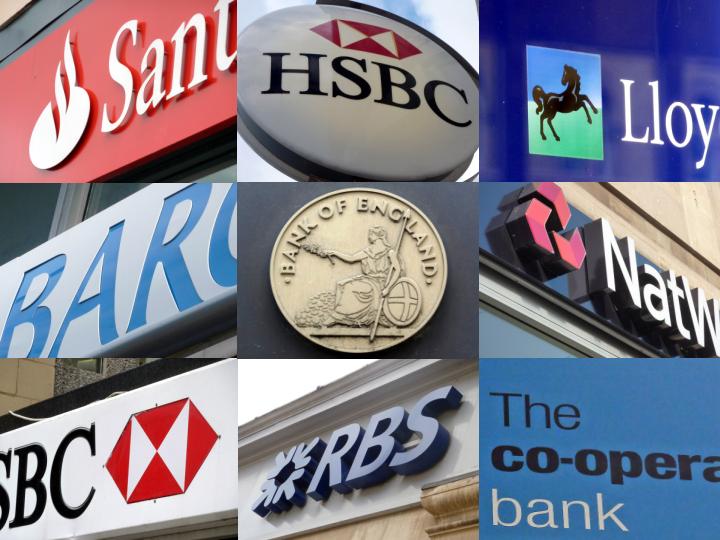 In a recent blog Accelerating interest in the interesting case of UK interest rates we compared the level of the official Bank Rate, which has now been at 0.5 per cent for over seven years, with a representative unsecured borrowing rate. In doing so, we found some evidence that credit conditions might be easing following the credit market disturbance of the late 2000s. Here we take the opportunity not only to review that data again one month on, but also to see whether a similar picture is true for the mortgage market.
In a recent blog Accelerating interest in the interesting case of UK interest rates we compared the level of the official Bank Rate, which has now been at 0.5 per cent for over seven years, with a representative unsecured borrowing rate. In doing so, we found some evidence that credit conditions might be easing following the credit market disturbance of the late 2000s. Here we take the opportunity not only to review that data again one month on, but also to see whether a similar picture is true for the mortgage market.
Theories of the financial accelerator argue that the macroeconomic environment can affect commercial banks’ lending practices. One way in which this can operate is through the difference between banks’ lending rates and the official Bank Rate. We can think of such interest-rate differentials – or spreads – as a credit premium. The size of the premium may be thought to reflect lenders’ perceived risk of default by borrowers. It is argued by some economists that interest-rate differentials will fall when the economy is doing well and increase when the economy is doing less well. This is because the probability of default by borrowers is seen as smaller when the macroeconomic environment improves.
The effect of interest-rate differentials that are contingent on the macroeconomic environment is to amplify the business cycle. For example, a positive demand-side shock, such as a rise in consumer confidence, which causes the economy’s aggregate demand to rise will, in turn, lead to lower borrowing rates relative to the official Bank Rate. This financial effect further stimulates the demand for credit and, as a consequence, aggregate demand and economic activity. It is an example of what economists called the financial accelerator.
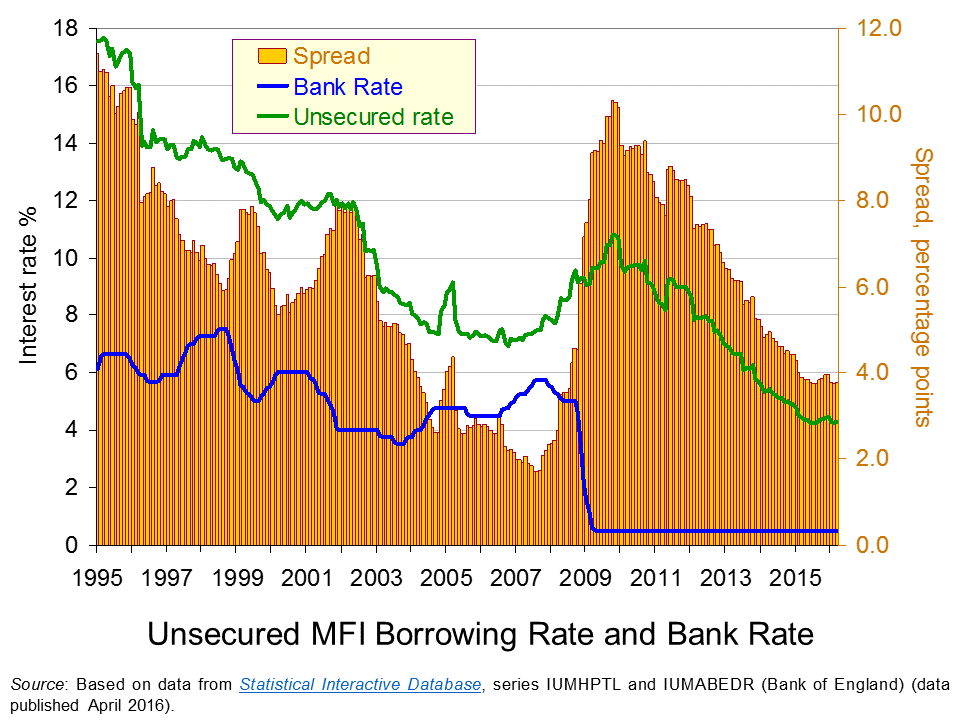 The chart shows the Bank Rate along with the average unsecured borrowing rate on loans by Monetary Financial Institutions (MFIs) of £10 000. Unlike secured borrowing, which we consider shortly, unsecured borrowing is not secured against property.
The chart shows the Bank Rate along with the average unsecured borrowing rate on loans by Monetary Financial Institutions (MFIs) of £10 000. Unlike secured borrowing, which we consider shortly, unsecured borrowing is not secured against property.
As expected, we can see that the unsecured borrowing rate is greater than the Bank Rate. In other words, there is a positive interest-rate differential. However, this differential is seen to vary. It falls sharply in the period up to the financial crisis. In early 2002 it was running at 8 percentage points. By summer 2007 the differential had fallen to only 1.7 percentage points. (Click here to download a PowerPoint of the chart.)
The period from 2002 to 2007 was characterised by consistently robust growth with the UK economy growing by about 2.7 per cent per annum over this period. This may point to economic growth can contributing to an easing of credit conditions as implied by the financial accelerator.
The story from 2008 changes very quickly as the interest-rate differential increases very sharply. In 2009, as the official Bank Rate was cut to 0.5 per cent, the unsecured borrowing rate climbed to close to 10.5 per cent. Consequently, the interest-rate differential rose to 10 percentage points. Inter-bank lending had dried up with banks concerned that banks would default on loans. The increase in interest rates on lending to the non-bank private sector was stark and evidence of a credit market disruption.
The interest-rate differential for unsecured borrowing has steadily declined since its peak at the end of 2009 as the unsecured borrowing rate has fallen. This implies that credit conditions have eased. In March 2016 our interest-rate differential for unsecured borrowing stood at 3.8 percentage points, not dissimilar to levels over the past 12 months. Interestingly, today’s differential on unsecured borrowing is lower than the 6.5 percentage point average over the period from 1997 to 2003, before the differential then went on its pre-crisis fall.
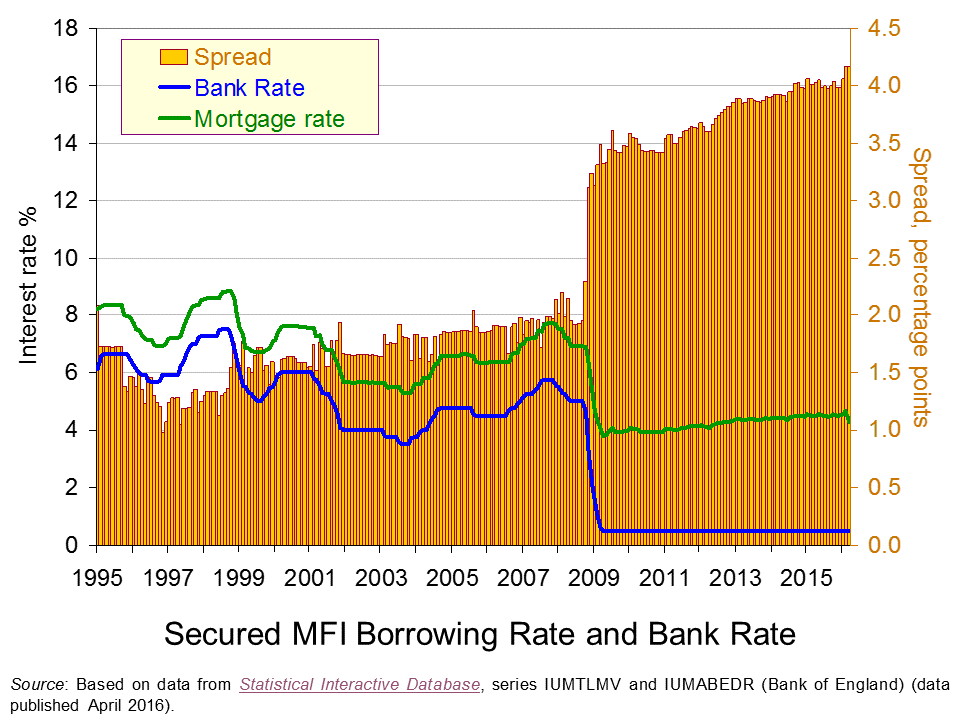 Our second chart repeats the analysis but this time for mortgages. The representative mortgage rate is the average standard variable mortgage rate.
Our second chart repeats the analysis but this time for mortgages. The representative mortgage rate is the average standard variable mortgage rate.
Unlike that for unsecured borrowing, the interest-rate differential for mortgages is fairly constant up to the financial crisis. The widely report credit easing in the mortgage market appears to have operated more through amounts lent rather than through price, as evidenced by rising mortgage advance-to-income ratios. (Click here to download a PowerPoint of the chart.)
The second chart shows clear evidence of a credit market disruption from 2009. Hence, the markets for secured and unsecured lending saw credit conditions tighten with interest-rate differentials rising markedly. However, it shows that the higher interest-rate differential for secured lending following the credit market disruption remains. So while the differential has fallen sharply for unsecured lending the situation is quite different in the mortgage market. In fact, February and March 2016 saw the mortgage rate spread at 4.17 percentage points which is an historic high.

Our interest rate data show that interest-rate differentials can vary significantly over time. This is important to understand when we are thinking about the relationships between the macroeconomy and the financial system. Significantly, the data suggest that interest rates on different financial instruments can behave differently such that differences emerge in the patterns of spreads over the official Bank Rate.
The evidence on UK mortgage rates suggests that the market remains affected by the financial crisis and the credit market disruption that arose. Although the level of mortgage rates is historically low – which tends to capture many of the headlines – this masks an historically high premium over the official Bank Rate.
Articles
Bank warns EU vote may hit growth as it holds rates BBC News, (14/4/16)
Carney issues a warning as interest rates are held Belfast Telegraph, (15/4/16)
Bank Of England Leaves Interest Rates On Hold Sky News, (14/4/16)
UK banks plan to boost lending to households but not firms – BoE Reuters, (13/4/16)
Mortgage rates reach record lows as threat of Bank Rate rise evaporates Telegraph, Tara Evans (1/4/16)
Data
Bankstats (Monetary and Financial Statistics) – Latest Tables Bank of England
Statistical Interactive Database – interest and exchange rates data Bank of England
Questions
- Why would we expect banks’ borrowing rates to be higher than the official Bank Rate?
- How might banks’ credit criteria change as the macroeconomic environment changes? Explain your answer.
- As well as the macroeconomic environment, what other factors might lead to a change in the interest-rate differential between banks’ borrowing rates and the official Bank Rate?
- How would we expect a credit market disruption to affect the interest-rate differential?
- Explain how the financial accelerator affects the change in the size of the economy following a positive demand shock.
- Explain how the financial accelerator affects the change in the size of the economy following a negative demand shock.
- What is the impact of the financial accelerator of the amplitude of the business cycle?
- How might regulators intervene to minimise the effect of the financial accelerator?
- Why might explain the high interest-rate differential on mortgages that continues to persist following the financial crisis?
- Analyse the ways in which the financial system can stabilise or destabilise economies.
We have learnt a lot this week about the appetite of households for spending. And, it appears that they are not particularly hungry. On Monday, the Quarterly National Accounts for Q1 revealed that, in real terms, household sector spending fell by 0.1% in the quarter despite disposable income growing by 2.1%. Today, we have learnt that households have continued to increase the amount of equity in their homes. The Housing Equity Withdrawal (HEW) figures for Q1 show that households increased their stake in housing by some £3.2 billion.
Housing Equity Withdrawal occurs when lending secured on dwellings increases by more than the investment in the housing stock. Housing investment relates largely to the purchase of brand new homes and to major home improvements, but also includes housing moving costs such as legal fees. What the Bank of England does is to compare these levels of housing investment with the amount of additional secured lending. If the Bank of England finds that additional secured lending is equal to the amount of housing investment then HEW is zero. If it is positive, then additional secured lending is greater than the levels of housing investment. This would show that the household sector was extracting equity from the housing stock and using mortgage lending to fund consumption, to purchase financial assets or to pay off unsecured debts, like credit cards.
But, the point here is that HEW is actually negative and has been so since the second quarter of 2008. Negative HEW means that housing investment levels are greater than the levels of new secured borrowing. In other words, household are increasing their housing equity. But, there is a cost to this choice because by doing so households are using money that could otherwise be assigned for spending or purchasing financial assets. One way of measuring the potential extent of foregone consumption is to note that the Bank estimates that the level of equity injected into housing in Q1 was equivalent to 1.3% of disposable income. Since Q2 2008 households have injected equity into housing to the tune of £38.34 billion, which is equivalent to 1.97% of disposable income, some of which might have otherwise been used to fund spending.
The negativity of HEW is not that surprising. In difficult economic times many of us might be tempted, if we can, to reduce our exposure to debt. Low interest rates may also be inducing households to pay off debt either because the interest rates on saving products are low and unattractive or because the size of mortgage payments for those on now lower variable rate mortgages gives them income with which to pay debt off. The bottom line is that after many years happily spending, households appear to be dining off a different menu.
Articles
Homeowners raise stakes in homes, says Bank of England BBC News (15/7/10)
Mortgage debt drops £3.2 billion Independent, Nicky Burridge (15/7/10)
Drop in outstanding mortgage debt UK Press Association (15/7/10)
Equity withdrawal still negative Financial Times, Cara Waters (15/7/10)
Saving may cause a double-dip recession Telegraph, Harry Wallop (13/7/10)
Data
Housing equity withdrawal (HEW) statistical releases Bank of England
Quarterly National Accounts, 1st Quarter 2010 ONS
Questions
- What do you understand by the term ‘housing equity withdrawal’?
- Compare the possible implications for consumer spending of positive HEW and negative HEW.
- What factors do you think lie behind the eight consecutive quarters of negative HEW?
- Why might a low interest rate environment affect the incentive to withdrawal housing equity? What other variables might also affect levels of HEW?
- How does HEW affect the net worth of households?
 We have reported frequently in our blogs about concerns over rising debt levels among UK households. We previously noted the concerns expressed in July 2014 by the Prudential Regulation Authority (PRA) that the growth in consumer credit (unsecured lending) was stretching the financial well-being of individuals with implications for the resilience of lenders’ credit portfolios. Now the Chief Executive of the Financial Conduct Authority (FCA), Andrew Bailey, in an interview to the BBC has identified the growing problem of debt among young people.
We have reported frequently in our blogs about concerns over rising debt levels among UK households. We previously noted the concerns expressed in July 2014 by the Prudential Regulation Authority (PRA) that the growth in consumer credit (unsecured lending) was stretching the financial well-being of individuals with implications for the resilience of lenders’ credit portfolios. Now the Chief Executive of the Financial Conduct Authority (FCA), Andrew Bailey, in an interview to the BBC has identified the growing problem of debt among young people. Mr Bailey goes on to echo concerns expressed back in July by the Prudential Regulation Authority in relation to the growth in consumer credit. The chart illustrates the scale of the accumulation of consumer credit (unsecured lending) across all individuals in the UK. In August 2017 the stock of unsecured debt rose to £203 billion, the highest level since December 2008 when the financial crisis was unfolding. (Click here to download a PowerPoint of the chart).
Mr Bailey goes on to echo concerns expressed back in July by the Prudential Regulation Authority in relation to the growth in consumer credit. The chart illustrates the scale of the accumulation of consumer credit (unsecured lending) across all individuals in the UK. In August 2017 the stock of unsecured debt rose to £203 billion, the highest level since December 2008 when the financial crisis was unfolding. (Click here to download a PowerPoint of the chart).





